April 30th, 2015
The Nepal Earthquake: A Harvard Fellow Shares Her Experience Near Everest Base Camp
Guest Blogger
Renee N. Salas, MD, MS, is a fellow in wilderness medicine in the Massachusetts General Hospital Department of Emergency Medicine. She is also an instructor of surgery at Harvard School of Medicine.
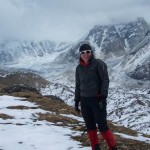 Dr. Renee Salas was working in a clinic below Mount Everest Base Camp when a 7.8-magnitude earthquake struck Nepal on April 25, 2015. She shares her perspective as an emergency responder.
Dr. Renee Salas was working in a clinic below Mount Everest Base Camp when a 7.8-magnitude earthquake struck Nepal on April 25, 2015. She shares her perspective as an emergency responder.
It was just after noon, and my colleagues and I were in the living space of the Himalayan Rescue Association (HRA) clinic in Pheriche, Nepal, which is below Everest Base Camp. As realization set in about the events that were occurring, we ran outside to see nearly all of the buildings of the small village of Pheriche crumbling, at least partly. About a third were completely destroyed. In the midst of screams and dust clouds, we quickly circled the village after the earthquake vibrations had settled to see if anyone was injured. Amazingly, the only injury was small — a head laceration. If this disaster had occurred at night, I fear the injury rate would have been much higher. The village came together as everyone comforted one another and assisted those who had completely lost their houses. Some even began rebuilding their stones walls after the initial waves of aftershocks.
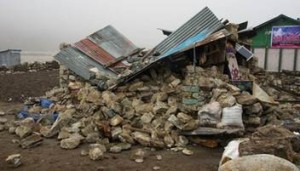 Due to the severity of the damage and the strength of the earthquake, we were very concerned that the gravity of the event as a whole was severe. This was my first experience with an earthquake, and the severity of the earth’s movement was astounding. I felt as if I were on a boat at sea. The immediate thoughts and concerns were to the status of the families of the Nepali workers here and to our HRA colleagues in Everest Base Camp and Manang. Unfortunately, we had few means to gain credible information. We had been without internet contact for the preceding few days, and the internet remained inoperable. We attempted to reach Everest Base Camp with the radio system we had in place but were unsuccessful. Through conversations that my Nepali friends had with family and the HRA headquarters in Kathmandu, we learned that the earthquake had affected the city, but we had no understanding of the severity. We then began to assess the damage to the clinic, which had thankfully been limited to only a portion of the living quarters and left the patient treatment area unaffected. The numerous aftershocks we experienced caused the villagers to remain outside for a good portion of the day. Unfortunately, it was snowing with moderate winds, making the situation more difficult.
Due to the severity of the damage and the strength of the earthquake, we were very concerned that the gravity of the event as a whole was severe. This was my first experience with an earthquake, and the severity of the earth’s movement was astounding. I felt as if I were on a boat at sea. The immediate thoughts and concerns were to the status of the families of the Nepali workers here and to our HRA colleagues in Everest Base Camp and Manang. Unfortunately, we had few means to gain credible information. We had been without internet contact for the preceding few days, and the internet remained inoperable. We attempted to reach Everest Base Camp with the radio system we had in place but were unsuccessful. Through conversations that my Nepali friends had with family and the HRA headquarters in Kathmandu, we learned that the earthquake had affected the city, but we had no understanding of the severity. We then began to assess the damage to the clinic, which had thankfully been limited to only a portion of the living quarters and left the patient treatment area unaffected. The numerous aftershocks we experienced caused the villagers to remain outside for a good portion of the day. Unfortunately, it was snowing with moderate winds, making the situation more difficult.
The first patients from Everest Base Camp were two climbing Sherpas who arrived about 9 hours after the earthquake, as they had immediately descended via foot and by horse. We saw and treated them — one was moderately injured and was admitted overnight and one with minor injuries was treated and released. We began to understand the gravity of what had occurred at Everest Base Camp as they recounted their experiences. We initially remained awake, believing that more would be arriving late that evening, but soon retreated to the sunroom (a free-standing building across from the clinic) to sleep given the continued aftershocks.
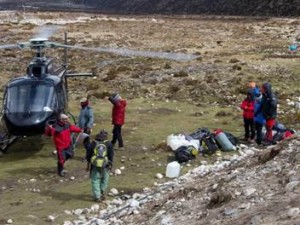 We awoke the next morning, a little before 6 AM, to the sounds of helicopter traffic heading up the valley. We received word that all of the critically ill and wounded from Everest Base Camp would be evacuated to our facility, and we quickly began preparing for the possibility of significant patient volume. This is exactly the type of mass casualty situation that my emergency medicine and wilderness medicine training prepared me for. Our clinic has two inpatient beds, one consult room bed, and another extra bed in our research room. Our physician staff includes me, Andrew Nyberg from the U.S., and Katie Williams from the U.K. Meg Walmsley from Australia, one of the Everest ER physicians, descended via helicopter that morning to assist with the large patient influx. Gobi Bashyal, our clinic manager, leaped into action and began making phone calls to the surrounding areas and country officials to obtain the necessary manpower and helicopters, while Thaneshwar Bhandari, our assistant manager, began assisting us with preparations. We quickly mobilized the sunroom into a patient facility, and the owner of the Panorama lodge next door, whose lodge was one of just two that had been unaffected by the quake, graciously donated his dining room. We received approximately 10 critically ill patients first and placed them in the clinic and sunroom — many on makeshift beds placed on the floor. There was a mix of Nepalis and international patients. Approximately 20-30 more suffered major injuries and were unable to ambulate. I cared for the most critically ill patients in the clinic and sunroom. In total, we saw and evacuated an estimated 73 patients, including many “walking wounded.” We utilized disaster training and placed large white stickers on patients with their names, injuries, vital signs, and medication administration times. Our resources here include intravenous fluids, medications, and ultrasound. However, we are a remote post without access to blood products or the ability to perform subspecialty procedures that many patients required. Luckily, the weather cleared, and we were able to arrange further evacuation down to the hospital in Lukla, which had more resources. Numerous helicopters, including an MI-17 — which could hold 16-18 patients — made many trips as all patients were evacuated over a 5-hour period.
We awoke the next morning, a little before 6 AM, to the sounds of helicopter traffic heading up the valley. We received word that all of the critically ill and wounded from Everest Base Camp would be evacuated to our facility, and we quickly began preparing for the possibility of significant patient volume. This is exactly the type of mass casualty situation that my emergency medicine and wilderness medicine training prepared me for. Our clinic has two inpatient beds, one consult room bed, and another extra bed in our research room. Our physician staff includes me, Andrew Nyberg from the U.S., and Katie Williams from the U.K. Meg Walmsley from Australia, one of the Everest ER physicians, descended via helicopter that morning to assist with the large patient influx. Gobi Bashyal, our clinic manager, leaped into action and began making phone calls to the surrounding areas and country officials to obtain the necessary manpower and helicopters, while Thaneshwar Bhandari, our assistant manager, began assisting us with preparations. We quickly mobilized the sunroom into a patient facility, and the owner of the Panorama lodge next door, whose lodge was one of just two that had been unaffected by the quake, graciously donated his dining room. We received approximately 10 critically ill patients first and placed them in the clinic and sunroom — many on makeshift beds placed on the floor. There was a mix of Nepalis and international patients. Approximately 20-30 more suffered major injuries and were unable to ambulate. I cared for the most critically ill patients in the clinic and sunroom. In total, we saw and evacuated an estimated 73 patients, including many “walking wounded.” We utilized disaster training and placed large white stickers on patients with their names, injuries, vital signs, and medication administration times. Our resources here include intravenous fluids, medications, and ultrasound. However, we are a remote post without access to blood products or the ability to perform subspecialty procedures that many patients required. Luckily, the weather cleared, and we were able to arrange further evacuation down to the hospital in Lukla, which had more resources. Numerous helicopters, including an MI-17 — which could hold 16-18 patients — made many trips as all patients were evacuated over a 5-hour period.
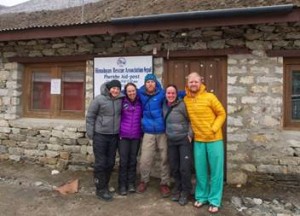 The local and international community here in the region came together in a way unlike anything I have ever experienced. Locals from the village and neighboring town of Dingboche assisted with transporting patients, arranging supplies, and giving patients and volunteers tea and food. International trekkers with nonmedical backgrounds who were in the region assisted selflessly with patient transport and donated first aid supplies and materials. We had numerous international physicians, nurses, and EMTs who spontaneously arrived and quickly set to work seeing patients, checking vital signs, and administering medications. When the last patient was evacuated, the nearly 100-200 people who had assisted all cheered and hugged one another for the amazing team effort… and then dispersed back to their villages while many international trekkers continued their descent to lower villages.
The local and international community here in the region came together in a way unlike anything I have ever experienced. Locals from the village and neighboring town of Dingboche assisted with transporting patients, arranging supplies, and giving patients and volunteers tea and food. International trekkers with nonmedical backgrounds who were in the region assisted selflessly with patient transport and donated first aid supplies and materials. We had numerous international physicians, nurses, and EMTs who spontaneously arrived and quickly set to work seeing patients, checking vital signs, and administering medications. When the last patient was evacuated, the nearly 100-200 people who had assisted all cheered and hugged one another for the amazing team effort… and then dispersed back to their villages while many international trekkers continued their descent to lower villages.
We have remained opened and will continue to see locals and trekkers until our job here is done. This likely won’t be until Everest Base Camp is cleared, and then we will convene with our Everest ER friends and colleagues and determine the next best course of action. Those descending from Everest Base Camp have shared their stories about their experiences on that fateful day, and we’ve tried to assist individuals as they attempt to learn about friends and loved ones. It has still been a very surreal situation that hasn’t truly hit home yet. There have been continued aftershocks that have served as jarring reminders that the danger is ongoing. Helicopter traffic has been constant between Everest Base Camp and Pheriche as climbers from Camps I/II and Everest Base Camp — and the bodies of the deceased — are evacuated.
Until we regained access to the internet yesterday evening, we had been in a vacuum with limited knowledge of the gravity of the situation within the remainder of this amazing country that has become our home for the past 2 months. This is a country full of loving people, and the innately welcoming culture has created a collaborative and selfless post-disaster environment here in the Khumbu Valley. However, this is a country with very limited resources. We spent the first week of March in Kathmandu for orientation before our acclimatization trek here, so I know parts of the city well. The situation in Kathmandu sounds grave as medical facilities have been quickly overwhelmed and they have struggled to take care of patients in damaged buildings and in the continued wake of aftershocks. The situation in the more remote outlying villages is unknown. As food and water resources dwindle and the lack of sanitation grows, risk for epidemics is high — which will turn an already dire situation into a nightmare. The country will require basic needs such as food/water and medical and infrastructure personnel and supplies. Any assistance, depending on your resources and abilities, would be greatly appreciated, including prayers. Similar to the Haiti earthquake aftermath, in which I participated, this will be a marathon and not a sprint as further pitfalls lie ahead as we attempt to rebuild this country. As I have limited knowledge of the true situation in Kathmandu, I cannot speak to specific needs currently, but these will become clear as time progresses and especially when I descend to the city in the coming 1 to 2 weeks.

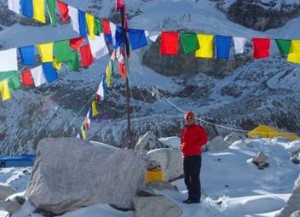

Dear Renée
I read your report with big interest and can give you a follow-up on the situation in Lukla. When we heard that all the injured people from Everest Base Camp were on their way to Lukla Airport, we established a “second look triage” in the intact building of the airport. I was lucky to have several medical doctors, nurses and paramedics who offered their help as volunteers. Due to the fact that Lukla Hospital suffered from severe damage and the risk of ongoing destruction was growing with every aftershock, the medical staff treated all patients outside. Fortunately the X-ray was working, and so we were able to add some diagnostics and therapy. Although we had the possibility to keep patients in the adjacent doctor’s house, almost all the patients wished to be flown to Kathmandu – although we did not have any information about the chances to receive medical treatment in the capital at that time.
The white stickers with information about the patient and the major medical problems were extremely useful. I would like to congratulate and thank you you for the excellent work you performed!
Dr. Monika Brodmann Maeder, senior consultant, Department of Emergency Medicine, Bern University Hospital, Switzerland
Member of Pasang Lhamu Nicole Niquille Hospital Lukla
Monika, Thx for your good work, and for this update; appreciated. I’ve forwarded to Renee who remains in country also. Jon
Dear Jon
Thank you very much for your kind reply. Give my best regards to Renée, and I hope that we will have the chance to make a debriefing with the involved physicians.
Monika
Dear all Medical teams,
I am happy to hear from your feedback about the situation and conditions of patients when the disaster struck. I do feel sorry for being not there to reach out to the victims. I do hope I could do more in future when they need us. Do keep my update if you all need me , I am from Singapore, General physician, and I have specialist cardiac nurse with me too. Hopefully we can build a small team to know you all and give our support to you too.
May Grace of LORD always with you, your family and all victims. you are all always in my prayer.
sincerely,
Dr Ng
It may be days since that devastating earthquake in Nepal. Their pain and suffering was felt all over the world. But thank fully there were some people who gave their all in response to this disaster……This is exactly the type of mass casualty situation that my emergency medicine and wilderness medicine training prepared me for. You we all ready and you did a great job. Thank you Doctor.